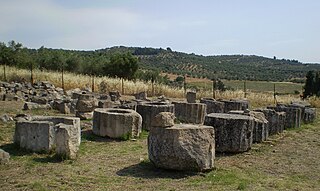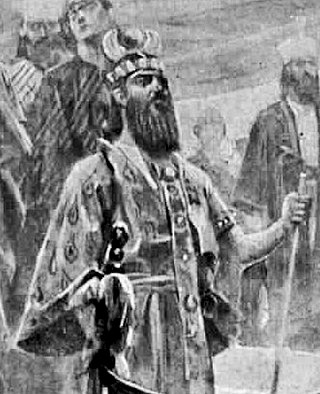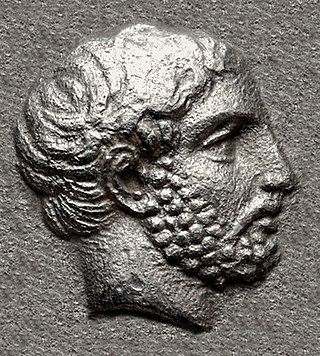Related Research Articles

Abae was an ancient town in the northeastern corner of ancient Phocis, in Greece, near the frontiers of the Opuntian Locrians, said to have been built by the Argive Abas, son of Lynceus and Hypermnestra, and grandson of Danaus. This bit of legend suggests an origin or at least an existence in the Bronze Age. Its protohistory supports a continued existence in Iron-Age antiquity. It was famous for its oracle of Apollo Abaeus, one of those consulted by Croesus, king of Lydia, and Mardonius, among others. The site of the oracle was rediscovered at Kalapodi and excavated in modern times. The results confirm an archaeological existence dating from the Bronze Age, as is suggested by the lore.
In Greek mythology, Assaracus was a king of Dardania.

Diodorus Siculus, or Diodorus of Sicily, was an ancient Greek historian. He is known for writing the monumental universal history Bibliotheca historica, in forty books, fifteen of which survive intact, between 60 and 30 BC. The history is arranged in three parts. The first covers mythic history up to the destruction of Troy, arranged geographically, describing regions around the world from Egypt, India and Arabia to Europe. The second covers the time from the Trojan War to the death of Alexander the Great. The third covers the period to about 60 BC. Bibliotheca, meaning 'library', acknowledges that he was drawing on the work of many other authors.
Agatharchides or Agatharchus of Cnidus was a Greek historian and geographer.
Euhemerus was a Greek mythographer at the court of Cassander, the king of Macedon. Euhemerus' birthplace is disputed, with Messina in Sicily as the most probable location, while others suggest Chios or Tegea.

Morgantina is an archaeological site in east central Sicily, southern Italy. It is sixty kilometres from the coast of the Ionian Sea, in the province of Enna. The closest modern town is Aidone, two kilometres southwest of the site. The site consists of a two-kilometre long ridge running southwest-northeast, known as Serra Orlando, and a neighboring hill at the northeast called Cittadella. Morgantina was inhabited in several periods. The earliest major settlement was made at Cittadella and lasted from about 1000/900 to about 450 BCE. The other major settlement was located on Serra Orlando, and existed from about 450 BCE to about 50 CE. Morgantina has been the subject of archaeological investigation since the early 20th century.

Oxyartes was a Sogdian or Bactrian nobleman of Bactria, father of Roxana, the wife of Alexander of Macedon.

Hecatomnus of Mylasa or Hekatomnos was an early 4th-century BC ruler of Caria. He was the satrap (governor) of Caria for the Persian Achaemenid king Artaxerxes II. However, the basis for Hecatomnus' political power was twofold: he was both a high appointed Persian official and a powerful local dynast, who founded the hereditary dynasty of the Hecatomnids. The Hecatomnids followed the earlier autochthonous dynasty of the Lygdamids in Caria.
The Partition of Triparadisus was a power-sharing agreement passed at Triparadisus in 321 BC between the generals (Diadochi) of Alexander the Great, in which they named a new regent and arranged the repartition of the satrapies of Alexander's empire among themselves. It followed and modified the Partition of Babylon made in 323 BC upon Alexander's death.
Pseudohermaphroditism is a condition in which an individual has a matching chromosomal and gonadal tissue sex, but mismatching external genitalia.

Bibliotheca historica is a work of universal history by Diodorus Siculus. It consisted of forty books, which were divided into three sections. The first six books are geographical in theme, and describe the history and culture of Egypt, of Mesopotamia, India, Scythia, and Arabia (II), of North Africa (III), and of Greece and Europe (IV–VI). In the next section, he recounts human history starting with the Trojan War, down to the death of Alexander the Great. The last section concern the historical events from the successors of Alexander down to either 60 BC or the beginning of Caesar's Gallic War in 59 BC. He selected the name "Bibliotheca" in acknowledgement that he was assembling a composite work from many sources. Of the authors he drew from, some who have been identified include: Hecataeus of Abdera, Ctesias of Cnidus, Ephorus, Theopompus, Hieronymus of Cardia, Duris of Samos, Diyllus, Philistus, Timaeus, Polybius and Posidonius.
In Greek mythology, Andreus may refer to two distinct individuals:

Aphroditus or Aphroditos was a male Aphrodite originating from Amathus on the island of Cyprus and celebrated in Athens.
Eurydice, often referred to as Adea Eurydice, was the Queen of Macedon, wife of Philip III and daughter of Amyntas IV and Cynane.

Intersex, in humans and other animals, describes variations in sex characteristics including chromosomes, gonads, sex hormones, or genitals that, according to the UN Office of the High Commissioner for Human Rights, "do not fit typical binary notions of male or female bodies". Intersex people were historically termed hermaphrodites, "congenital eunuchs", or even congenitally "frigid". Such terms have fallen out of favor, now considered to be misleading and stigmatizing.
Aulus Manlius Vulso was a Roman politician in the 5th century BC, and was a member of the first college of the decemviri in 451 BC. In 474 BC, he may have been elected consul with Lucius Furius Medullinus. Whether or not the decemvir is the same man as the consul of 474 BC remains unknown.
Lucius Furius Medullinus was a Roman politician in the 5th century BC, and consul in 474 BC.
In Greek mythology, Ilus was the founder of the city called Ilios or Ilion to which he gave his name. When the latter became the chief city of the Trojan people it was also often called Troy, the name by which it is best known today. In some accounts, Ilus was described to have a plume of horsehair.
Luc Brisson is a Canadian historian of philosophy and anthropologist of antiquity. He is emeritus director of research at the CNRS in France, and is considered by some of his colleagues and students to be the greatest contemporary scholar on Platonism.
Diophantus, born Herais, was an intersex person who lived in the second century BC and fought as a soldier with Alexander Balas. His life is known from the works of Diodorus Siculus.
References
- 1 2 3 4 Diodorus, Siculus (2007). The historical library of Diodorus the Sicilian in fifteen books : the first five contain the antiquities of Egypt, Asia, Africa, Greece, the islands, and Europe : the last ten an historical account of the affairs of the Persians, Grecians, Macedonians and other parts of the world : to which are added the fragments of Diodorus that are found in the Bibliotheca of Photius : together with those publish'd by H. Valesius, L. Rhodomannus, and F. Ursinus / made English by G. Booth ..., Esq.
- 1 2 Tougher, Shaun (2020-11-12). The Roman Castrati: Eunuchs in the Roman Empire. Bloomsbury Publishing. ISBN 978-1-350-16404-8.
- ↑ Rolker, Christof. "Ideas on Yde and Ydé: (un)gendered names in classical and medieval literature". Männlich-weiblich-zwischen (in German). Retrieved 2021-06-25.
- 1 2 3 4 "Exploring Gender and Sexuality in Antiquity: The Trial and Consciousness of Callon". SENTENTIAE ANTIQUAE. 2018-10-23. Retrieved 2021-06-24.
- ↑ C. S. Bartsocas (2001-07-01). "An Endocrinologist's View of Genetic Disorders in Ancient Greece". International Journal on Disability and Human Development. 2 (3): 131–140. doi:10.1515/IJDHD.2001.2.3.131. ISSN 2191-0367. S2CID 147099598.
- ↑ Pfuntner, Laura (2020). "Between Science and Superstition: Photius, Diodorus Siculus, and "Hermaphrodites"". Dumbarton Oaks Papers. 74: 269–284. ISSN 0070-7546. JSTOR 26979085.
- 1 2 Langlands, Rebecca (2002). "'Can You Tell What it is Yet?' Descriptions of Sex Change in Ancient Literature". Ramus. 31 (1–2): 91–110. doi:10.1017/S0048671X00001387. ISSN 0048-671X. S2CID 134711309.
- 1 2 Markantes, Georgios; Deligeoroglou, Efthimios; Armeni, Anastasia; Vasileiou, Vasiliki; Damoulari, Christina; Mandrapilia, Angelina; Kosmopoulou, Fotini; Keramisanou, Varvara; Georgakopoulou, Danai; Creatsas, George; Georgopoulos, Neoklis (2015-07-10). "Callo: The first known case of ambiguous genitalia to be surgically repaired in the history of Medicine, described by Diodorus Siculus". Hormones. 14 (3): 459–461. doi: 10.14310/horm.2002.1608 . PMID 26188239.
- ↑ Brisson, Luc (2002-03-28). Sexual Ambivalence: Androgyny and Hermaphroditism in Graeco-Roman Antiquity. University of California Press. p. 37. ISBN 978-0-520-22391-2.
- ↑ Stackelberg, Katharine T. von (2020-05-29). "hermaphroditism". Oxford Research Encyclopedia of Classics. doi:10.1093/acrefore/9780199381135.013.8090. ISBN 978-0-19-938113-5 . Retrieved 2021-06-24.